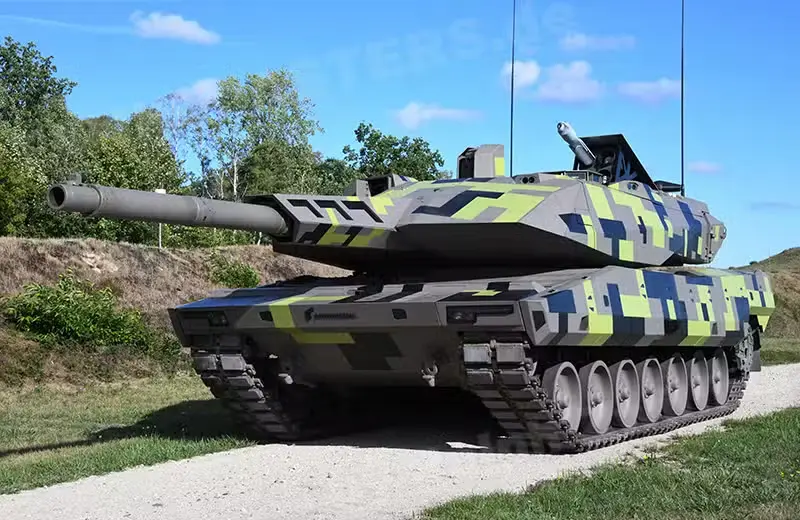
The Leopard 3 is not just a rehash of the Leopard 2, it’s a next-gen platform
Leopard 3 – As Europe braces for a new era of defense challenges, Germany is making a decisive move to modernize its armored forces. The Leopard 3, often referred to as the Leopard 2AX, is emerging as the Bundeswehr’s interim main battle tank (MBT) for the 2030s, a bridge between the current Leopard 2A8 and the ambitious Main Ground Combat System (MGCS) planned for the 2040s.
Why an Interim Tank?
Germany’s defense planners have recognized that simply upgrading existing platforms won’t suffice in the face of evolving threats. With Russia deploying advanced tanks like the T-90M, and the battlefield increasingly shaped by loitering munitions, smart artillery, and anti-tank missiles, the Leopard 3 is designed to fill the gap until MGCS arrives.
Unlike France, which has opted to wait for MGCS, Germany is investing in a transitional solution that offers cutting-edge capabilities without compromising long-term plans.
Key Features of the Leopard 3
The Leopard 3 is not just a rehash of the Leopard 2, it’s a next-gen platform built on lessons from Ukraine and other modern conflicts. Here’s what sets it apart:
- 130mm Rheinmetall L/51 Cannon: A massive upgrade over the 120mm gun, offering 50% more kinetic energy and enhanced armor penetration.
- Automatic Loader: Required to handle the larger, heavier rounds, improving rate of fire and crew safety.
- Advanced Ammunition Suite: Including DM11 (high-explosive), DM13 (qualification), and DM23 (armor-piercing) shells.
- OLYMP Propulsion System: A new engine from Liebherr, designed for agility and modularity, replacing the traditional MTU powerplant.
- MUSS 2.0 Protection System: Enhanced self-defense against guided missiles, lasers, and kinetic threats, with optical signal detection capabilities.
- Digital Integration: Expected to include reconnaissance drones, loitering munitions, and AI-assisted targeting systems.
Development Timeline
Germany’s Ministry of Defense has already awarded contracts to KNDS Deutschland, Rheinmetall, and Hensoldt for technical studies covering firepower, mobility, and protection. These studies are scheduled to conclude by late 2026, with the Leopard 3 expected to enter service in the early 2030s.
The tank is projected to have a 20–25 year operational lifespan, aligning with Germany’s strategy to keep pace with rapid technological evolution.
Strategic Implications
Germany’s decision to pursue the Leopard 3 reflects a broader shift in European defense posture. With NATO urging member states to increase defense spending, potentially reaching 3% of GDP by 2030—Berlin is positioning itself to lead the European armored vehicle market.
The Leopard 3 could become a popular export, especially among countries already operating Leopard 2 variants. Its modular design and compatibility with existing infrastructure make it an attractive option for militaries seeking rapid modernization.
Relationship with MGCS
Importantly, the Leopard 3 is not a competitor to MGCS but a complementary solution. It allows Germany to maintain operational readiness while MGCS undergoes development. The MGCS, a Franco-German joint project, is expected to be a multi-platform system integrating crewed and uncrewed vehicles, with revolutionary capabilities beyond traditional MBTs.
Despite past tensions—such as Germany’s preference for the 130mm cannon over France’s ASCALON—the MGCS program remains active and collaborative.
Final Thoughts
The Leopard 3 is more than a stopgap, it’s a strategic statement. It signals Germany’s commitment to innovation, readiness, and leadership in armored warfare. As the world watches the evolution of battlefield technology, the Leopard 3 stands as a symbol of adaptability and foresight.
Whether it ultimately bears the name “Leopard 3” or remains the Leopard 2AX, one thing is clear: Germany isn’t waiting for the future, it’s building it.
Would you like a visual breakdown of its features or a comparison with other tanks like the KF-51 Panther or MGCS?
Stay updated with the latest news on Rapido Updates. Keep yourself updated with The World, India News, Entertainment, Market, Automobile, Gadgets, Sports, and many more
1 thought on “Leopard 3: Germany’s Bold Leap Toward the Future of Armoured Warfare”
Comments are closed.